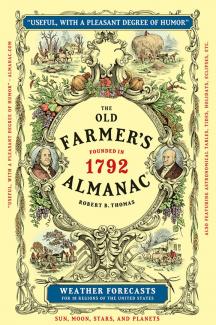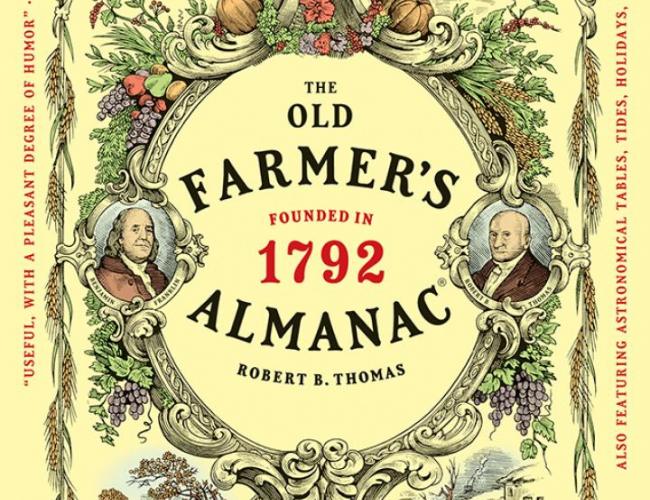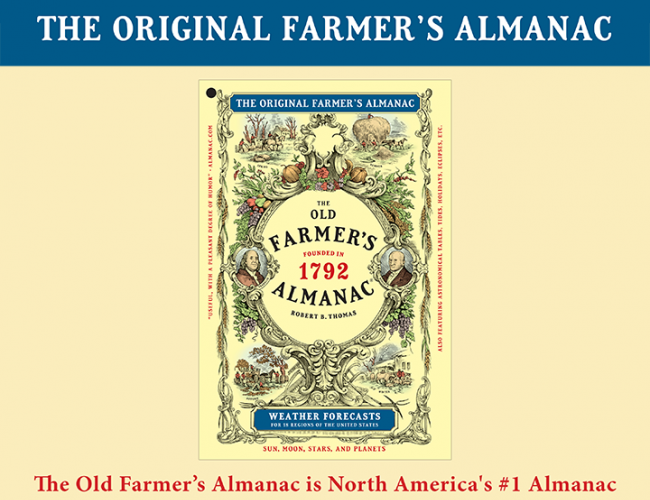Here are writer’s guidelines for The Old Farmer’s Almanac.
Advertisement
Some Background
The Old Farmer’s Almanac is the oldest continuously published periodical in North America and the most popular “farmer’s almanac” by far.
Since 1792, it has provided useful information for people in all walks of life: tide tables for those who live near or work on the ocean; sunrise tables and planting charts for those who live on the farm or simply enjoy gardening; recipes for those who like to cook; and forecasts for those who don’t like the question of weather left up in the air.
In 1982, we began publishing a Canadian edition. It contains Ottawa-based astronomical data and several Canada-focused features by Canadian writers. (See topics below.)
The words of the Almanac’s founder, Robert B. Thomas, guide us still: “Our main endeavor is to be useful, but with a pleasant degree of humor.” Wit and wisdom is our stock in trade.
What is an Almanac?
An almanac, by definition, records and predicts astronomical events (the rising and setting of the Sun, for instance), tides, weather, and other phenomena with respect to time. In recent years, we’ve expanded the Almanac content—but always with an eye on Mr. Thomas’s wise words about keeping things fun and practical.
The Old Farmer’s Almanac can be defined as
- A calendar of the heavens, featuring calendrical and astronomical articles and data (Sun/Moon rise/set times, length of day, tide times, and celestial sightings, and the like).
- A calendar of the year, marking annual and seasonal events, including civil and religious holidays; daily astronomical events; astrological “best” days and cycles; agricultural/gardening and gestation days, and more.
- A time capsule of year, with stories that capture the mood, spirit, habits, trends, and/or esoteric interests of the times. (One goal is to produce a “snapshot” of the issue year so that readers looking back in 2, 20, or 200 years will understand and appreciate what life was like.)
- A reference book, offering tips and advice on a variety of topics, often expressed through a feature article, such as the 2005 features “How to Be a Genius, or at least a little smarter than you are now,” which also commemorated the 50th anniversary of Albert Einstein’s death, and “How to Win at Pet Shows and County Fairs.” (This also explains why the Almanac is often found in the “Reference” section of bookstores and libraries and why we feature many “how-to” or instructional articles.)
What topics are covered as features in this Almanac?
We bring timeless topics to the page under a variety of categories: amusement, astronomy, folklore, food, gardening, history, home remedies, husbandry, nature/outdoors, pets, romance, sports/fishing, weather, and others. We celebrate and commemorate past people and events with historic or “anniversary” stories that shed new light on the subject and/or update the subject with the latest information. (An anniversary year is typically one that is divisible by 5, but preferably is 25, 50, or 100 years ago.)
We often feature a “special report” on a topic of broad general interest. In the past, those have included romance, superstitions, and wedding traditions past and present.
We especially encourage humor of all kinds: the fanciful, the bizarre, the ludicrous, and the offbeat. The best humor seems to be a true tale well told—for example, using ear wax as lip gloss; how to hypnotize a chicken/lobster/frog; cooking with condiments (from packets); and how to forecast the weather with a pig spleen. Little-known profiles are also welcome. We have covered, for example, the first woman over Niagara Falls in a barrel, a dog who could read minds, and pet heroes.
Explore this Web site, Almanac.com, to see the scope of what we do; we often supplement stories with additional information (sidebars, links, videos, blogs). For more about the history of this publication, click here.
What kinds of stories are not published in this Almanac?
We do not publish personal/first-person essays, recollections, or reflections written as childhood/family memories (e.g., “My First Pony”) or accounts of personal experiences in our topic areas (such as “How I Learned to be More Patient”). Nor do we run political discourses. And we do not publish fiction. Read an issue or two to understand better how to write for this Almanac.
Who reads The Old Farmer’s Almanac?
Our readership spans the generations: Slightly more of it is women. Readers range in age from 9 to 90. Fifty-eight percent of them live on an acre or less, which is to say that they live in the suburbs (and are small-space gardeners); the remainder are mostly farmers or ranchers. They are, to a man (and woman), “information seekers”: They enjoy the bits and pieces of data, trivia, and esoteric details in a story, as well as the proverbs and quotes with which we embellish many features and that are found on the Almanac’s right-hand “calendar” pages.
Deadlines and Details
The Almanac is officially released every year in late August. It is available for purchase wherever books and newspapers are sold or on our Web site, Almanac.com. (We do not sell back issues on the Web site and can not direct you to them elsewhere.)
We begin producing the “next” issue in the spring prior to the cover-date year. For example, in May 2019, we start assigning stories for the 2021 issue. Stories are assigned from then until about November and accepted until January. Payment is made on acceptance; rates vary. We prefer to buy all rights.
If you have a story idea, please mail your query/ies to The Old Farmer’s Almanac, P. O. Box 520, Dublin, NH 03444, and include a self-addressed, stamped envelope if you would like a response. If you have been published (especially in the proposed topic area) provide a sample of clips in hard copy.
For all article queries, you can e-mail the Editor of The Old Farmer’s Almanac here.
Thank you for your interest in The Old Farmer’s Almanac.






Comments